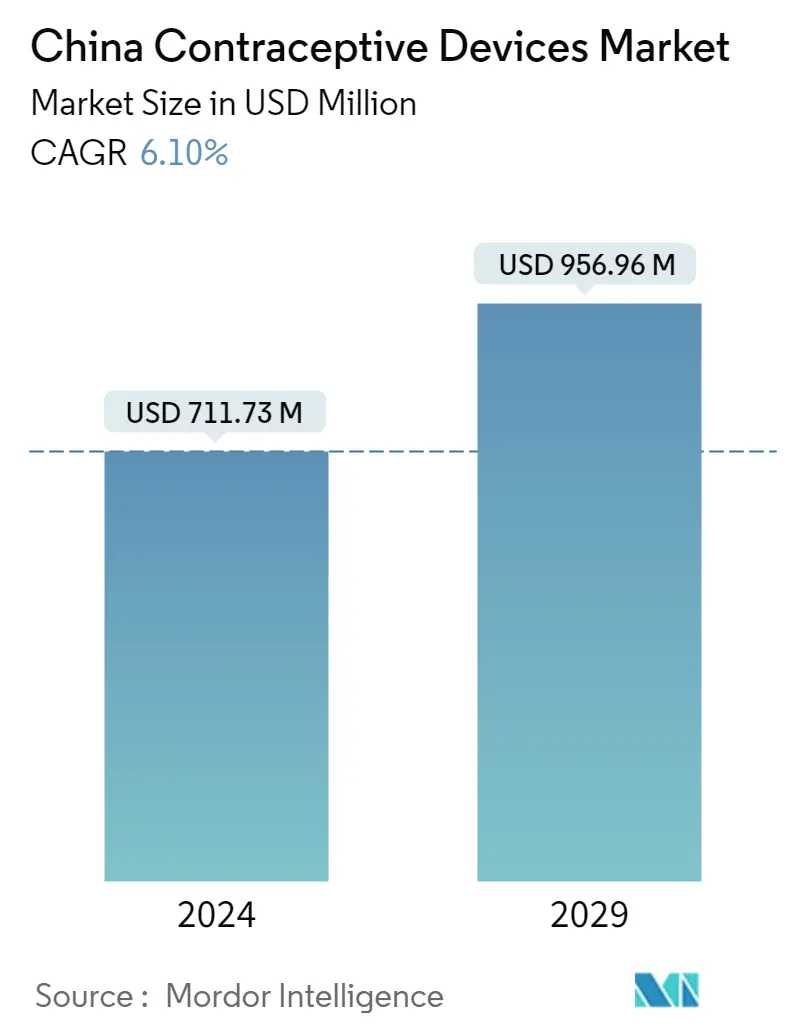Market Size of China Contraceptive Devices Industry

| Study Period | 2019 - 2029 |
| Base Year For Estimation | 2023 |
| Forecast Data Period | 2024 - 2029 |
| Market Size (2024) | USD 711.73 Million |
| Market Size (2029) | USD 956.96 Million |
| CAGR (2024 - 2029) | 6.10 % |
Major Players
*Disclaimer: Major Players sorted in no particular order |
China Contraceptive Devices Market Analysis
The China Contraceptive Devices Market size is estimated at USD 711.73 million in 2024, and is expected to reach USD 956.96 million by 2029, growing at a CAGR of 6.10% during the forecast period (2024-2029).
The COVID-19 pandemic has had a substantial impact on the Chinese contraceptive devices market. The strict lockdowns and government regulations increased the usage of contraceptive devices. For instance, according to an article published by Nature in August 2021, a significant decrease was observed in the frequency of sexual intercourse in China during the COVID-19 pandemic. However, a significant increase in contraceptive device usage was seen, including condoms, the rhythm method, and the coitus interruptus method, during the pandemic. Thus, the COVID-19 pandemic affected the market's growth favorably in its preliminary phase. However, the market is expected to lose traction post the pandemic.
Factors such as growing cases of sexually transmitted diseases and rising government initiatives with respect to the prevention of these diseases are expected to contribute significantly to the market's growth. According to an article published by PubMed in October 2022, a study conducted in China showed that the overall positive rate of reproductive tract infections among the 4,39,372 women of reproductive age was 5.03%. The most common infection was candidiasis, which accounted for 2.47%, bacterial vaginosis at 1.28%, syphilis at 0.73%, T. vaginalis at 0.49%, C. trachomatis at 0.20%, and N. gonorrhoeae at 0.06%. Thus, there is a rising need for preventive measures for such diseases, which is expected to boost the demand for contraceptive devices in the market.
In addition, new product launches and strategic activities by major players in the market are positively affecting the growth of the studied market. Therefore, owing to such factors, the studied market is anticipated to witness growth over the forecast period. However, the side effects associated with the contraceptive devices are likely to impede the market's growth.
China Contraceptive Devices Industry Segmentation
As per the scope of the report, contraceptive devices are barriers that attempt to avoid pregnancy by physically preventing sperm from entering the uterus. Contraception, more commonly known as fertility and birth control, is described as the method used to avoid pregnancy. Types of contraceptive devices include male condoms, female condoms, cervical caps, diaphragms, and contraceptive sponges with spermicide.
The Chinese contraceptive devices market is segmented by product type (condoms, diaphragms, intrauterine devices, and other product types) and end user (female and male). The report offers the value (USD million) for the above segments.
| By Product Type | |
| Condoms | |
| Diaphragms | |
| Intrauterine Devices | |
| Other Product Types |
| By End User | |
| Male | |
| Female |
China Contraceptive Devices Market Size Summary
The Chinese contraceptive devices market is poised for growth, driven by a combination of factors including increased awareness of sexually transmitted diseases and supportive government initiatives aimed at disease prevention. The COVID-19 pandemic initially boosted the market as usage of contraceptive devices rose during lockdowns, although post-pandemic, the market is expected to stabilize. The demand for contraceptive devices is further fueled by the need for preventive measures against prevalent reproductive tract infections. The market is characterized by the presence of both international and local players, with companies like GUANGZHOU ICLEAR HEALTHCARE LIMITED, Bayer Healthcare, and Cooper Surgical Inc. holding significant shares. Strategic activities such as new product launches and price reductions, like those by DKT WomanCare, are also contributing to market expansion.
Intrauterine devices (IUDs) are anticipated to experience significant growth due to their high effectiveness and the growing body of research supporting their use, even among individuals at high risk of HIV infections. The market's fragmented nature is evident with numerous companies competing for market share, and recent government campaigns in China aim to raise awareness about contraceptive devices, potentially further boosting market growth. Despite the positive outlook, the market faces challenges from the side effects associated with contraceptive devices, which could impede growth. Overall, the Chinese contraceptive devices market is expected to witness steady growth over the forecast period, supported by ongoing research, strategic market activities, and government initiatives.
China Contraceptive Devices Market Size - Table of Contents
-
1. MARKET DYNAMICS
-
1.1 Market Overview
-
1.2 Market Drivers
-
1.2.1 Rising Cases of Sexually Transmitted Diseases
-
1.2.2 Government Initiatives Regarding the Usage of Contraceptive Devices
-
-
1.3 Market Restraints
-
1.3.1 Side Effects Associated with Contraceptive Devices
-
-
1.4 Porter's Five Forces Analysis
-
1.4.1 Threat of New Entrants
-
1.4.2 Bargaining Power of Buyers/Consumers
-
1.4.3 Bargaining Power of Suppliers
-
1.4.4 Threat of Substitute Products
-
1.4.5 Intensity of Competitive Rivalry
-
-
-
2. MARKET SEGMENTATION
-
2.1 By Product Type
-
2.1.1 Condoms
-
2.1.2 Diaphragms
-
2.1.3 Intrauterine Devices
-
2.1.4 Other Product Types
-
-
2.2 By End User
-
2.2.1 Male
-
2.2.2 Female
-
-
China Contraceptive Devices Market Size FAQs
How big is the China Contraceptive Devices Market?
The China Contraceptive Devices Market size is expected to reach USD 711.73 million in 2024 and grow at a CAGR of 6.10% to reach USD 956.96 million by 2029.
What is the current China Contraceptive Devices Market size?
In 2024, the China Contraceptive Devices Market size is expected to reach USD 711.73 million.

